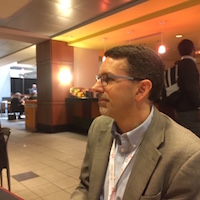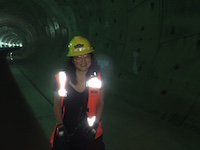Happy 2018! In my 22nd year at ENR, it’s my honest regret that I haven’t done more to record the many cool aspects of being the transportation editor over the years. Memory fuzzes, and great moments are lost forever, and tidbits of information that don’t get into print are wasted. No more time to waste!
My January got off to the perfect start with the Transportation Research Board, which ran in the first week of the month, earlier than typical. Along with the now-standard fare of automated vehicles and infrastructure (under) funding, there was quite a bit of “lessons learned” talk. One panel discussed the legacy of the Interstate highway and how construction often bisected communities, uprooted historic structures and demoralized downtowns. The Various projects have since attempted to mitigate damage done by the original construction. One example is the Long Street Cap and Cultural Wall in Columbus, where I-70 and I-71 isolated predominantly minority communities. “It was the path of least resistance to highway building,” said Erica Schneider, assistant environmental administrator with the Ohio DOT. “The Interstate went around affluent areas.”
The Columbus Crossroads project aims to alleviate the congestion and safety problems caused by the two highways by “untangling” them with features such as two new urban avenues providing direct access to downtown, 18 interchange bridges and six access ramps connecting arterial streets. A 240-ft Long Street cultural wall with 64 4 ft x 8 ft panels feature artwork by two local artists celebrating the community’s history. “We are trying to fix the damage done in the 1960s,” said Schneider.
I also chatted with Dr. Jeremy Gregory, executive director of the MIT Concrete Sustainability Hub. His group is focusing study on concrete’s lifecycle, not just the material aspects. “The ‘use’ phase is more important than what’s in the material,” he says. That is, design and maintenance impacts on fuel consumption, reflectivity, climate effects, concrete degradation and numerous other factors are taken into account. Minimizing fuel consumption by maintaining concrete pavement translates to lesser GHGs, he says. Even the color of the concrete can affect pollution effects. Gregory’s team is working with the FHWA on lifecycle assessment of concrete pavements and has performed studies for various DOTs.

It was a great discussion – not aggregate-ing at all.
Another great session examined “failed” P3 road projects in the U.S., including the South Bay Expressway, the Pocahontas Parkway, SH 130 in Texas, and I-69 in Indiana. The common themes: Despite going through bankruptcy, ultimately these projects did not “fail,” said presenters—at least not in the public sense. Various risks and factors played roles, but ultimately the roads remain open. However, private investors came away with a lot of lessons learned, not the least of which is to take time to know each specific region’s unique conditions.
A 7-hour tour (including lunch at Dulan’s, a venerable soul food joint) of the Crenshaw-LAX light-rail line in mid-January was incredible. Not noted in my cover story is the rigorous safety protocol: at each section of the job (bored tunnel, cut-and-cover section, elevated airport section, at-grade track work section), we were greeted by a construction person, briefed on current activities and potential worksite dangers, and signed in and out.
While everyone always claims great partnerships between clients and construction team on every project, I can say with confidence that when design-build team guys (Walsh-Shea) are giving friendly shade to reps from the owner (Metro) all day long, that’s a pretty good sign that this is a true team.

ENR leadership (Scott Seltz, publisher; Jan Tuchman, editor-in-chief; Scott Blair, ENR California editor Christine Kilpatrick) came to town for the Beavers and the Low-Bidders events, and toured a bunch of projects. I went along on the Sixth Street Bridge, which I will write about later this year as it takes shape. It will be eye-popping and mind-boggling.
Had fun at the Beavers, but really miss attending the Moles in NYC with Urban Engineers.
Finally, correspondent Greg Aragon and I attended a topping-out ceremony in my home city of Long Beach for the Aquarium of the Pacific’s 29,000-sq-ft Pacific Visions wing. Local ironworkers attached the traditional Scandinavian tree (for long life of the building), American flag and broom (no recordable injuries to date) and hauled the steel beam into place. Greg and I were among the many people signing the beam, but the most popular signee by far was a Magellanic Penguin.

Read about it in Greg’s blog here.
To come in February: A WTS rail discussion in downtown LA, a Western Winter workshop with West Coast construction industry officials (Winter! In Palm Springs!) and me getting a year older—almost as old as the Interstate, but hopefully I’m not functionally obsolete or structurally deficient yet.

Post a comment to this article
Report Abusive Comment